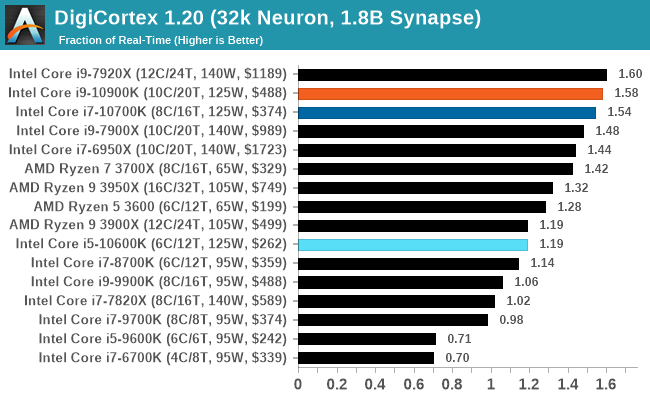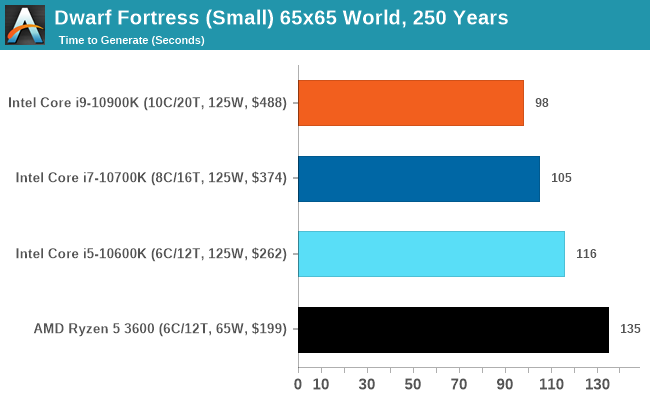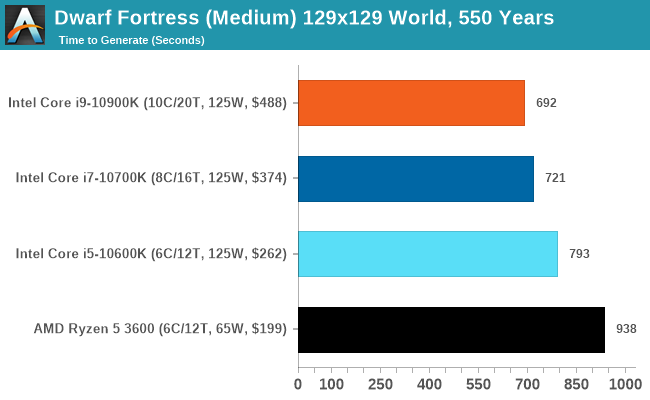The Intel Comet Lake Core i9-10900K, i7-10700K, i5-10600K CPU Review: Skylake We Go Again
by Dr. Ian Cutress on May 20, 2020 9:00 AM EST- Posted in
- CPUs
- Intel
- Skylake
- 14nm
- Z490
- 10th Gen Core
- Comet Lake
CPU Performance: Simulation Tests
A number of our benchmarks fall into the category of simulations, whereby we are either trying to emulate the real world or re-create systems with systems. In this set of tests, we have a variety including molecular modelling, non-x86 video game console emulation, a simulation of the equivalent of a slug brain with neurons and synapses firing, and finally a popular video game that simulates the growth of a fictional land including historical events and important characters within that world.
NAMD ApoA1
One frequent request over the years has been for some form of molecular dynamics simulation. Molecular dynamics forms the basis of a lot of computational biology and chemistry when modeling specific molecules, enabling researchers to find low energy configurations or potential active binding sites, especially when looking at larger proteins. We’re using the NAMD software here, or Nanoscale Molecular Dynamics, often cited for its parallel efficiency. Unfortunately the version we’re using is limited to 64 threads on Windows, but we can still use it to analyze our processors. We’re simulating the ApoA1 protein for 10 minutes, and reporting back the ‘nanoseconds per day’ that our processor can simulate. Molecular dynamics is so complex that yes, you can spend a day simply calculating a nanosecond of molecular movement.
This is one of our new tests, so we will be filling in more data as we start regression testing for older CPUs.

Dolphin 5.0: Console Emulation
One of the popular requested tests in our suite is to do with console emulation. Being able to pick up a game from an older system and run it as expected depends on the overhead of the emulator: it takes a significantly more powerful x86 system to be able to accurately emulate an older non-x86 console, especially if code for that console was made to abuse certain physical bugs in the hardware.
For our test, we use the popular Dolphin emulation software, and run a compute project through it to determine how close to a standard console system our processors can emulate. In this test, a Nintendo Wii would take around 1050 seconds.
The latest version of Dolphin can be downloaded from https://dolphin-emu.org/

DigiCortex 1.20: Sea Slug Brain Simulation
This benchmark was originally designed for simulation and visualization of neuron and synapse activity, as is commonly found in the brain. The software comes with a variety of benchmark modes, and we take the small benchmark which runs a 32k neuron / 1.8B synapse simulation, equivalent to a Sea Slug.
Example of a 2.1B neuron simulation
We report the results as the ability to simulate the data as a fraction of real-time, so anything above a ‘one’ is suitable for real-time work. Out of the two modes, a ‘non-firing’ mode which is DRAM heavy and a ‘firing’ mode which has CPU work, we choose the latter. Despite this, the benchmark is still affected by DRAM speed a fair amount.
DigiCortex can be downloaded from http://www.digicortex.net/

The additional bandwidth of the HEDT platforms put them higher up the chart here - Digicortex always ends up as an odd mix of bottlenecks mostly around memory, but it can be localized internal bandwidth limited as well.
Dwarf Fortress
Another long standing request for our benchmark suite has been Dwarf Fortress, a popular management/roguelike indie video game, first launched in 2006. Emulating the ASCII interfaces of old, this title is a rather complex beast, which can generate environments subject to millennia of rule, famous faces, peasants, and key historical figures and events. The further you get into the game, depending on the size of the world, the slower it becomes.
DFMark is a benchmark built by vorsgren on the Bay12Forums that gives two different modes built on DFHack: world generation and embark. These tests can be configured, but range anywhere from 3 minutes to several hours. I’ve barely scratched the surface here, but after analyzing the test, we ended up going for three different world generation sizes.
This is another of our new tests.














220 Comments
View All Comments
Boshum - Wednesday, May 20, 2020 - link
Pfft. You are hilarious.Spunjji - Tuesday, May 26, 2020 - link
Maxipad, the latest in the line of Gondalf imitators.Adm_SkyWalker - Wednesday, May 20, 2020 - link
Once again I find myself debating if I should upgrade. My current i7-6950X has held up better than I thought it would. I guess it's another year or two wait for me.Boshum - Wednesday, May 20, 2020 - link
I would be good with a beast like that for 5 more years.Icehawk - Saturday, May 23, 2020 - link
I’d wait until a component like mobo dies, that’s what got me to move from a 3770 about a year ago to a 8700 - mobo died and they were pricy and old. Replaced my wife’s i5 from same gen with a 3900X though recently and gave her the intel box. I’m a gamer but I do a lot of encoding so felt AMD offered a better mix and allows me to use my 450W fanless PSU. But aside from encoding speed I barely notice a difference from that 3700.Dug - Wednesday, May 20, 2020 - link
The problem with all these charts is that they are inconsistent.There are so many variables that aren't shown that it doesn't make sense to show these.
Most of this has to do with how motherboards handle the cpu's and what their default settings do.
There can be a 15% swing in AMD motherboard default settings between brands. Not to mention things like pbo on or off, infinity fabric, memory timings, etc.
I don't know about the Intel side. I remember their settings made less difference unless it was just cpu clock speed.
shady28 - Wednesday, May 20, 2020 - link
Agree with the sentiment, but you kinda stacked the deck with that last statement.Most of the Z490s are now supporting much higher speed RAM (up to DDR4-5000) and even intel 9th gen were good at overclocked RAM, while AMD systems rarely get above 3600Mhz. It shows if you look at something like PCMark 10 where the top 100 systems on almost all of the charts is completely dominated by intel. All of them are overclocked of course, but all of the top AMD systems are also overclocked.
What I would like to see is something along the lines of a i5-10600K vs AMD 3600 vs AMD 3600X, but not using 'all the same components other than mobo and CPU'. Take those 3 chips and build the fastest system you can with them. Use that PCI 4.0 NVMe and GPU on AMD, use that 4800Mhz CAS 18 RAM on the Intel. See what happens.
mrvco - Wednesday, May 20, 2020 - link
Ok, part of me would be curious to see what Intel could (or couldn't) do with an 11th Gen spin of their 14nm process.Findecanor - Wednesday, May 20, 2020 - link
The "Security" portion of this article is not really comprehensible. I can't guess what the author is thinking. The author needs to write it down in actual words what these things mean.Security on Intel processors is what is holding me off from buying any Intel CPU for the time being.
I consider myself pretty knowledgeable about the actual vulnerabilities themselves, and how they work, and how they can be mitigated -- in theory --, but if I have not kept up with every little tidbit of news about security on Intel's processors in particular, that portion of the article tells me absolutely NOTHING.
quadibloc - Wednesday, May 20, 2020 - link
These chips are impressive, and for people with a need to build a system today, and a preference for Intel, they are reasonably competitive. So I am favorably impressed, even if AMD would remain my own choice at the moment. I still do believe that in the long run, Intel does have the means to regain leadership, so that in a year or two or five, AMD will be back to being in second place (but in second place like the previous generations of Ryzens, not like the Bulldozer years). I don't know, though, if even Intel will be able to keep up at the process end; even it may have to go fabless after 10nm, which would have significant implications for the industry.